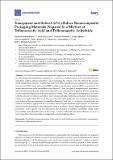Por favor, use este identificador para citar o enlazar a este item:
http://hdl.handle.net/10261/178941COMPARTIR / EXPORTAR:
 SHARE SHARE
 CORE
BASE CORE
BASE
|
|
| Visualizar otros formatos: MARC | Dublin Core | RDF | ORE | MODS | METS | DIDL | DATACITE | |

| Título: | Transparent and Robust All-Cellulose Nanocomposite Packaging Materials Prepared in a Mixture of Trifluoroacetic Acid and Trifluoroacetic Anhydride |
Autor: | Guzmán-Puyol, Susana; Ceseracciu, Luca; Tedeschi, Giacomo; Marras, Sergio; Scarpellini, Alice; Benítez, José J. CSIC ORCID; Athanassiou, Athanassia; Heredia-Guerrero, José A. CSIC ORCID | Palabras clave: | All-cellulose nanocomposites Trifluoroacetic acid Trifluoroacetic anhydride Transparency Robustness Packaging material |
Fecha de publicación: | 5-mar-2019 | Editor: | Multidisciplinary Digital Publishing Institute | Citación: | Nanomaterials 9(3): 368 (2019) | Resumen: | All-cellulose composites with a potential application as food packaging films were prepared by dissolving microcrystalline cellulose in a mixture of trifluoroacetic acid and trifluoroacetic anhydride, adding cellulose nanofibers, and evaporating the solvents. First, the effect of the solvents on the morphology, structure, and thermal properties of the nanofibers was evaluated by atomic force microscopy (AFM), X-ray diffraction (XRD), and thermogravimetric analysis (TGA), respectively. An important reduction in the crystallinity was observed. Then, the optical, morphological, mechanical, and water barrier properties of the nanocomposites were determined. In general, the final properties of the composites depended on the nanocellulose content. Thus, although the transparency decreased with the amount of cellulose nanofibers due to increased light scattering, normalized transmittance values were higher than 80% in all the cases. On the other hand, the best mechanical properties were achieved for concentrations of nanofibers between 5 and 9 wt.%. At higher concentrations, the cellulose nanofibers aggregated and/or folded, decreasing the mechanical parameters as confirmed analytically by modeling of the composite Young’s modulus. Finally, regarding the water barrier properties, water uptake was not affected by the presence of cellulose nanofibers while water permeability was reduced because of the higher tortuosity induced by the nanocelluloses. In view of such properties, these materials are suggested as food packaging films | Versión del editor: | http://dx.doi.org/10.3390/nano9030368 | URI: | http://hdl.handle.net/10261/178941 | DOI: | 10.3390/nano9030368 | ISSN: | 2079-4991 |
| Aparece en las colecciones: | (ICMS) Artículos |
Ficheros en este ítem:
| Fichero | Descripción | Tamaño | Formato | |
|---|---|---|---|---|
| nanomaterials-09-00368.pdf | 3,09 MB | Adobe PDF |  Visualizar/Abrir |
CORE Recommender
PubMed Central
Citations
8
checked on 16-may-2024
SCOPUSTM
Citations
33
checked on 17-may-2024
WEB OF SCIENCETM
Citations
28
checked on 29-feb-2024
Page view(s)
183
checked on 21-may-2024
Download(s)
116
checked on 21-may-2024

